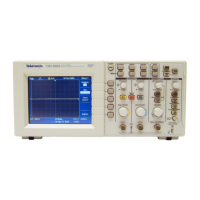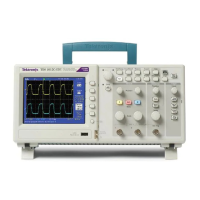Command Syntax
2-8
TDS200, TDS1000/2000, TDS1000B/2000B, TPS2000 Programmer
H Any query that returns arbitrary data, such as ID?, must be the
last query when part of a concatenated command. If the query is
not last, the oscilloscope generates event message 440.
Here are some INVALID concatenation examples:
H CH1:COUPling DC;ACQuire:NUMAVg 16
(missing colon before ACQuire)
H CH1:COUPling DC;:BANDwidth ON
(invalid colon before BANDwidth)
H CH1:COUPling DC;:*TRG
(invalid colon before a star (*) command)
H HORizontal:MAIn:POSition 0;MAIn:SCAle 1E–13
(levels of mnemonics are different—either remove th e second
occurrence of MAIn:, or put :HORizontal: in front of
MAIN:SCAle)
Message Terminators
This manual uses the term <EOM> (End of message) to represent a
message terminator.
GPIB End of Message (EOM) Terminators. GPIB EOM terminators can
be the END message (EOI asserted concurrently with the last data
byte), the ASCII code for line fee d (LF) sent as the last data byte, or
both. The oscilloscope always terminates messages with LF and EOI.
White space is allowed before the terminator; for example, CR LF is
acceptable.
USB End of Message (EOM) Terminators. The EOM bit must be set in
the USB header of the last transfer of a command message. See the
USB Test and Measurement Class Specification (USBTMC) section
3.2.1 for details. The oscilloscope terminates messages by setting
the EOM bi t in the USB header of the last transfer of a message to
the host (USBTMC Specification section 3.3.1), and by terminating
messages with a LF. White space is allowed before the terminator;
for example, CR LF is acceptable.
